|
Saturday
29
November 2003
After
breakfast we have again coffee at
Gerbaud. At the Tourist Info we ask for directions to the Statue Park. The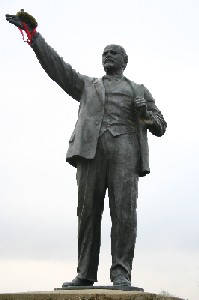 receptionist looks a bit troubled and asks if we really want to go there since
it would be a complicated journey. We insist and get some instructions. We take
a red numbered bus #7-713 from Ferenc Tér to Étele Tér (terminus). There we
change to the yellow Volanbusz in the direction of Diösd-Erd (bay 7 or 8). We
have to buy a ticket in the terminal building as our week pass is not valid on
these busses. The bus brings us exactly in front of the entrance to the Statue
Park or Szoborpark. It is not that complicated after all. During the
transition from communism to democracy in 1990, the city districts were allowed
to decide what to do with the statues in their area. Those statues that were
removed ended up here. The park opened its doors in 1993. There are huge statues
of Marx, Engels and Lenin. Also Hungarian leaders like Bela Kun (who was
secretly shot in Moscow on Stalin's orders) and Jenö Landler (who lies buried
in the Kremlin wall) are repres
receptionist looks a bit troubled and asks if we really want to go there since
it would be a complicated journey. We insist and get some instructions. We take
a red numbered bus #7-713 from Ferenc Tér to Étele Tér (terminus). There we
change to the yellow Volanbusz in the direction of Diösd-Erd (bay 7 or 8). We
have to buy a ticket in the terminal building as our week pass is not valid on
these busses. The bus brings us exactly in front of the entrance to the Statue
Park or Szoborpark. It is not that complicated after all. During the
transition from communism to democracy in 1990, the city districts were allowed
to decide what to do with the statues in their area. Those statues that were
removed ended up here. The park opened its doors in 1993. There are huge statues
of Marx, Engels and Lenin. Also Hungarian leaders like Bela Kun (who was
secretly shot in Moscow on Stalin's orders) and Jenö Landler (who lies buried
in the Kremlin wall) are repres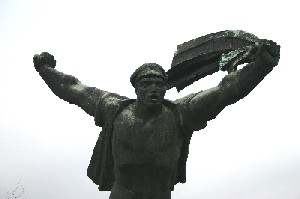 ented. Here we find the statue of the Russian soldier that once
held the liberty monument
company on Gellért Hill and some 25 other
socially-realistic top pieces. The most telling statue is the one commemorating
the Republic of Councils of 1919,
based on a revolutionary poster from that year representing a charging sailor.
Also impressive is the memorial for Bela Kun who is surrounded by a crowd of
workers and soldiers. The removal from the city of the monument in honour of the
Hungarian Brigade in the Spanish Civil War, caused much controversy, which was
hardly ever the case for the others. The collection is impressive but laid out
in a very basic setting, located in a forgotten outpost of the city. After about
40 minutes we have seen it all. The souvenir shop sells nostalgia from the red
past. ented. Here we find the statue of the Russian soldier that once
held the liberty monument
company on Gellért Hill and some 25 other
socially-realistic top pieces. The most telling statue is the one commemorating
the Republic of Councils of 1919,
based on a revolutionary poster from that year representing a charging sailor.
Also impressive is the memorial for Bela Kun who is surrounded by a crowd of
workers and soldiers. The removal from the city of the monument in honour of the
Hungarian Brigade in the Spanish Civil War, caused much controversy, which was
hardly ever the case for the others. The collection is impressive but laid out
in a very basic setting, located in a forgotten outpost of the city. After about
40 minutes we have seen it all. The souvenir shop sells nostalgia from the red
past.
We
take the busses back into town, have lunch and prepare for a visit to the Géllert
baths. These are based at the Géllert
hotel
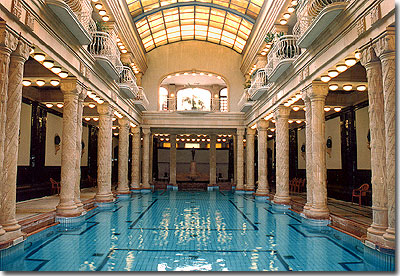 near the Géllert bridge. A beautiful Art Nouveau building with thermal water.
There is a bubbling swimming pool and a couple of thermal baths. Entry for both
costs a hefty HUF 2100 (€8.50). If you stay less than 2 hours you get HUF 900
(€3.60) back as
you leave. If you stay under 3 hours the refund is HUF 600 (€2.40). The
Gellert baths are visited by lots of tourists and all signs have English and
German translations. Entry ticket is a
plastic card with a bar code. Here too, you are guided to changing cabins who are
locked after you by an attendant. You receive a metal number plate on a short
cord. The number does NOT correspond with the number of your cabin, it is
written by the attendant on a slate inside the cabin (as proof). You have to make
a mental note of your cabin number.
We go to the pool (bathing suit obligatory), which is cool and bubbly
near the Géllert bridge. A beautiful Art Nouveau building with thermal water.
There is a bubbling swimming pool and a couple of thermal baths. Entry for both
costs a hefty HUF 2100 (€8.50). If you stay less than 2 hours you get HUF 900
(€3.60) back as
you leave. If you stay under 3 hours the refund is HUF 600 (€2.40). The
Gellert baths are visited by lots of tourists and all signs have English and
German translations. Entry ticket is a
plastic card with a bar code. Here too, you are guided to changing cabins who are
locked after you by an attendant. You receive a metal number plate on a short
cord. The number does NOT correspond with the number of your cabin, it is
written by the attendant on a slate inside the cabin (as proof). You have to make
a mental note of your cabin number.
We go to the pool (bathing suit obligatory), which is cool and bubbly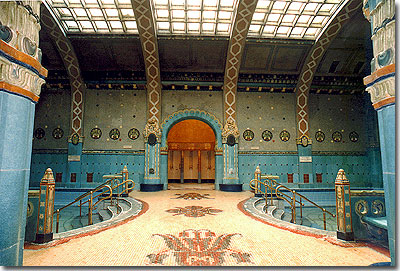 (not smelly). After having done some lanes of breast stroke we go to the thermal
baths, which are separate for men and women. The men walk around in a loin cloth
leaving the buttocks uncovered. There is a large pool of 38°C/100°F and one of
36°/96°F. Besides that there is a steam room (very hot) and a cold plunge pool
(18°C/64°F) and dry saunas of 60, 80 and 90°C (140/176/194°F). A tour around
the baths, steamrooms and saunas makes us very relaxed and at ease. The atmosphere
is very relaxed too (not cruisy at all like the Király). After more than 90
minutes we are satisfied and make for the exit. Upon leaving the building the
turnstile gate produces a receipt which we have to present to the refund cashier
to get our refund. We go for a drink at the Amstel River cafe and after that to
the guest house.
(not smelly). After having done some lanes of breast stroke we go to the thermal
baths, which are separate for men and women. The men walk around in a loin cloth
leaving the buttocks uncovered. There is a large pool of 38°C/100°F and one of
36°/96°F. Besides that there is a steam room (very hot) and a cold plunge pool
(18°C/64°F) and dry saunas of 60, 80 and 90°C (140/176/194°F). A tour around
the baths, steamrooms and saunas makes us very relaxed and at ease. The atmosphere
is very relaxed too (not cruisy at all like the Király). After more than 90
minutes we are satisfied and make for the exit. Upon leaving the building the
turnstile gate produces a receipt which we have to present to the refund cashier
to get our refund. We go for a drink at the Amstel River cafe and after that to
the guest house.
We
take a break before we leave for dinner. We have booked a table at the Arcade
restaurant in Buda. We take the metro to Deli Pu railway station from which it is a 10 minute
walk. We end up in a residential area where we least of all expect a decent
restaurant. Just when we think we have completely lost our way we find ourselves
in front of the restaurant that looks quite stylish and sophisticated.
Service turns out to be excellent and the food is well prepared and delicious.
Lamb cutlets, Salmon Tartare. The pace between courses is - just like yesterday -
a bit high and in less than no time we have completed the 4 course dinner. We
leave the place 90 minutes after we arrived - satisfied about the food and
drink.
After
the meal we take the metro back into Pest. We go to the Cappella bar. It is
supposed to be a gay dance club. Once inside we find there is no seat left and
the place is full of straight young couples. We leave and take a taxi to the
Angel bar. This is a 100% gay dance club. An entertaining drag show starts
at midnight. After that we dance the night away on the clubs dance floor. Good
atmosphere and many cute men. Some time after 2am we call it a night and leave.
,
Sunday
30
November 2003
We
start with coffee at Gerbaud. From there we walk to the Dohány synagogue.
This is supposed to be the largest synagogue in Europe and the second largest in
the World .
The building was designed by a gentile Austrian architect in a Moorish-Byzantine
style. This was a popular style around 1850. We buy a ticket for the English
tour. The main hall is impressively large and richly decorated. The lay-out
reflects the synagogue's Neolog identity, a Hungarian Jewish denomination with
elements from the liberal and conservative traditions. We are allowed to take
photos, but this implies a donation towards the upkeep of the building. At
special request the ark is opened we are allowed a peek on the thora
rolls. .
The building was designed by a gentile Austrian architect in a Moorish-Byzantine
style. This was a popular style around 1850. We buy a ticket for the English
tour. The main hall is impressively large and richly decorated. The lay-out
reflects the synagogue's Neolog identity, a Hungarian Jewish denomination with
elements from the liberal and conservative traditions. We are allowed to take
photos, but this implies a donation towards the upkeep of the building. At
special request the ark is opened we are allowed a peek on the thora
rolls.
The
tour continues along the cemetery for the victims of the 1944/45 winter in the
ghetto. Behind the synagogue is a courtyard with a silver "weeping
willow" in the middle. Each leaf carries the name of a family that fell
victim to the holocaust. There is also a plaque in honour of the Swedish
diplomat Raoul Wallenberg
and other helpers of the Jews in the 1944  and
'45, who saved many from a certain death. Finally we are lead into the Jewish
Museum. The museum has 4 rooms. The first room contains religious items for the
Jewish holy services, like thora rolls. The second room is devoted to Jewish
holidays. The third room shows aspects of Jewish daily life, while the last room
is dedicated to the holocaust in Budapest. An elderly gentleman leads us through
the rooms and explains the exhibits from first hand experience, with lots of
interesting details. He stresses that the prosecution of the Jews did not
start until 1944 when the Germans helped the Hungarian fascist movement, Arrow
Cross, to seize power. The SS under the leadership of Adolf Eichmann could never
have been so effective without the active help of the then Hungarian government.
Especially the Jewish population on the countryside has been all but
decimated. and
'45, who saved many from a certain death. Finally we are lead into the Jewish
Museum. The museum has 4 rooms. The first room contains religious items for the
Jewish holy services, like thora rolls. The second room is devoted to Jewish
holidays. The third room shows aspects of Jewish daily life, while the last room
is dedicated to the holocaust in Budapest. An elderly gentleman leads us through
the rooms and explains the exhibits from first hand experience, with lots of
interesting details. He stresses that the prosecution of the Jews did not
start until 1944 when the Germans helped the Hungarian fascist movement, Arrow
Cross, to seize power. The SS under the leadership of Adolf Eichmann could never
have been so effective without the active help of the then Hungarian government.
Especially the Jewish population on the countryside has been all but
decimated.
After
the visit we have lunch. Then we take the tram to the Margarit-island. This
island lies in the middle of the Danube and can be reached by a bridge
connecting Buda and Pest.
It
is a fairly big island and a popular for a Sunday stroll, 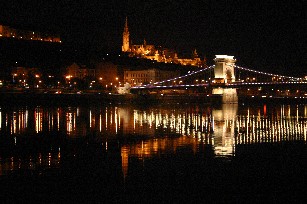 especially
with joggers. There are several sport facilities. We rent a bike (battered to
put it mildly; one of them has a broken chain before we leave the rental place)
and cycle the 5km around the island. It is a nice little tour with a view of the
city. After the ride we take the tram along the ring road towards the Oktogon
square. From their we walk back to the guest house via Andrassy ut
("Budapest's answer to Broadway"). especially
with joggers. There are several sport facilities. We rent a bike (battered to
put it mildly; one of them has a broken chain before we leave the rental place)
and cycle the 5km around the island. It is a nice little tour with a view of the
city. After the ride we take the tram along the ring road towards the Oktogon
square. From their we walk back to the guest house via Andrassy ut
("Budapest's answer to Broadway").
At
night we have cocktails at the Meridien hotel, followed by a simple meal in the
Amstel River Café. We take a last evening stroll along the Danube and enjoy the
lovely view on nicely lit palace, castle hill and Chain Bridge. We take the
metro from Vörósmarty
tér back to the Opera and walk back to the guest house.
It
was a gray, yet dry day with temperatures around 10°C/50°F.
Monday
1 December 2003
Breakfast
at the 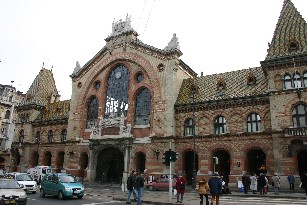 guest
house, followed by coffee at Gerbaud. This has been our morning routine here in
Budapest. Now is time to some shopping. We buy some shoes for Erik at HUMANIC.
They are fairly cheap. Let's hope they are any good. We walk along the Vaci ut,
the main shopping street in downtown Pest. The stretch between Vörosmarty Tér
and Ferenc Tér is very busy and lined with chain stores. Beyond Ferenc Tér it
is quieter, the shops are of better quality and the street has more atmosphere.
We pass the old Town Hall and continue towards the big Market Hall.
On the ground level of the Hall we find mostly stalls selling meat, vegetables
and fruit. The galleries of the upper level are more for textiles, be it guest
house, followed by coffee at Gerbaud. This has been our morning routine here in
Budapest. Now is time to some shopping. We buy some shoes for Erik at HUMANIC.
They are fairly cheap. Let's hope they are any good. We walk along the Vaci ut,
the main shopping street in downtown Pest. The stretch between Vörosmarty Tér
and Ferenc Tér is very busy and lined with chain stores. Beyond Ferenc Tér it
is quieter, the shops are of better quality and the street has more atmosphere.
We pass the old Town Hall and continue towards the big Market Hall.
On the ground level of the Hall we find mostly stalls selling meat, vegetables
and fruit. The galleries of the upper level are more for textiles, be it 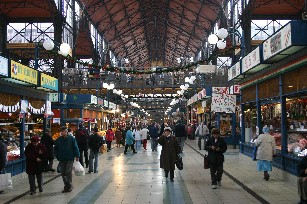 mostly
of the touristy variety: lots of embroidered table cloths and
aprons. mostly
of the touristy variety: lots of embroidered table cloths and
aprons.
We
wander along the Danube again towards the centre and have a snack at the Mac.
Finally we take Andrassy Ut towards the Opera and from there to our guest house.
It is time to leave for the airport. The guest house owner calls us a taxi. Not
our favourite Fötaxi but a cheaper one. After a few minutes a battered Opel
Astra estate pulls up in front of the guest house. We get in but the metre is
not running. We ask for the price, and get a quote for HUF 3000. Not bad, in any
case less than we paid on the way here. What then follows is a hair raising high
speed race through numerous narrow streets and alleys. After a couple of minutes
we have completely lost track of where we are. After 15 minutes we reach the
highway out of town, which encourages our "Ayrton Senna" to go even
faster. We overtake left, right and center and are very much relieved when we
reach the airport in one piece.
Checking
in for our flight seems to take forever. At least 10 to 15 minutes per
passenger. We have to wait a while before boarding. We land in Amsterdam around
6.20pm. Our suitcases appear soon after that on the conveyor belt and we can
catch the 6.40 train home.
|





